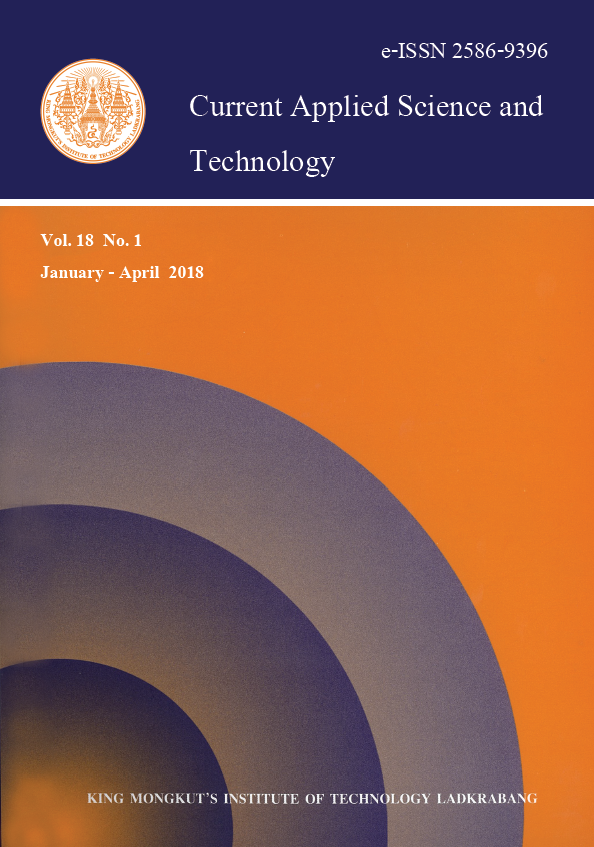Effects of Yanang (Tiliacora triandra) Gum on Gelation of Waxy Rice Flour
Main Article Content
Abstract
Crude hydrocolloid extract has been prepared from the leaves of Yanang (Tiliacora triandra). This research studied effects of Yanang gum on pasting and textureal properties of blending of waxy rice flour. Rapid visco analysis (RVA) results showed that the ratio of Yanang extract to water of 1:3 and 1:4 (w/w) significantly decreased the trough, breakdown, and final viscosities of the waxy rice flour whereas the peak viscosities, peak time, and pasting temperatures of the blends were increased. Textural study revealed that the addition of crude Yanang gum enhanced more hardness and springiness of the blending gels than those of waxy rice flour gel, whereas cohesiveness was less affected. These results would be useful as a guideline for developing frozen starch-based food products containing crude Yanang gum.
Keywords: Yanang, hydrocolloid, waxy rice flour, pasting properties, textural properties, RVA
Corresponding author: Tel.: 08-1899-7447 Fax: 0-2522-6609
E-mail: iwisut.s@gmail.com
Article Details
Copyright Transfer Statement
The copyright of this article is transferred to Current Applied Science and Technology journal with effect if and when the article is accepted for publication. The copyright transfer covers the exclusive right to reproduce and distribute the article, including reprints, translations, photographic reproductions, electronic form (offline, online) or any other reproductions of similar nature.
The author warrants that this contribution is original and that he/she has full power to make this grant. The author signs for and accepts responsibility for releasing this material on behalf of any and all co-authors.
Here is the link for download: Copyright transfer form.pdf
References
[2] BeMiller, J.N., 2007. (2nd ed.). Carbohydrate chemistry for food scientists St. Paul, MN: AACC International Inc.
[3] Appelqvist, I.A.M. and Debet, M.R.M., 1997. Starch-biopolymer interactions-A review. Food Rev. Int., 13, 163-224.
[4] BeMiller, J. N., 2011. Pasting, paste, and gel properties of starch–hydrocolloid combinations. Carbohydr. Polym., 86, 386-423.
[5] Singthong, J., Ningsanond, S. and Cui, S.W., 2009. Extraction and physicochemical characterisation of polysaccharide gum from Yanang (Tiliacora triandra) leaves. Food Chem., 114, 1301-1307.
[6] Samutsri, W. and Po-Eang, T., 2016. The development of Yanang (Tiliacora triandra) leather product. 799-807p. in: Proceeding of the 4th International Symposium on Fundamental and Applied Sciences (ISFAS2016). Higher Education Forum, Kyoto, Japan.
[7] Rakkhumkaew N., 2017. Effects of different hydrocolloids on properties of gluten-free bread based on small broken rice berry flour. Food Sci. Technol. Int., 23(4), 310-317.
[8] Samutsri, W. and Suphantharika, M., 2012. Effect of salts on pasting, thermal, and rheological properties of rice starch in the presence of non-ionic and ionic hydrocolloids. Carbohydr. Polym., 87, 1559-1568.
[9] Huang, C-C., Lin, M-C. and Wang, C-CR., 2006. Changes in morphological, thermal and pasting properties of yam (Dioscorea alata) starch during growth. Carbohydr. Polym., 64, 524-531.
[10] Han, J-A., Lee, B-H., Lim, W.J. and Lim, S-T., 2005. Utilization of hydroxypropylated waxy rice and corn starches in Korean waxy rice cake to retard retrogradation. Cereal Chem., 82(1), 88-92.
[11] Charoenrein, S. and Preechathammawong, N., 2011. Improving structure of rice starch gel to resist freeze-thaw process by addition of Thai polysaccharides. In: Proceeding of the 11th International Congress on Enginerring and Food (ICEF11). May 22-26 2011. School of Chemical Engineering, National Technical University of Athens, Athens, Greece.
[12] Newport Scientific., 1998. Interpretation, Application Manual for the Rapid Visco Analyzer. Sydney, Newport Scientific Pty. Ltd.
[13] Akesowan, A., 2002. Viscosity and Gel Formation of a Konjac Flour from Amorphophallus oncophyllus. AU Journal of Technol., 5(3), 139-146.
[14] Sanderson, G.R., 1990. Gellan gum. in: Food Gels. P. Harris, ed. Elsevier: New York. pp. 201-232.


